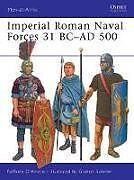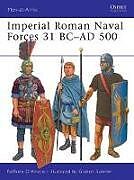Imperial Roman Naval Forces 31 BCAD 500
Einband:
Kartonierter Einband
EAN:
9781846033179
Untertitel:
Englisch
Genre:
Politikwissenschaft
Autor:
Raffaele DAmato
Herausgeber:
Osprey Publishing
Anzahl Seiten:
48
Erscheinungsdatum:
10.11.2009
ISBN:
978-1-84603-317-9
Informationen zum Autor Dr Raffaele D'Amato is an experiencd Turin-based reseracher of the ancient world. He is an external professor to the Athens University School of Philosophy and Material Culture. This is his first book for Osprey.Graham Sumner was born in 1958. He studied illustration at Wrexham Art School and has specialised in archaeological reconstruction drawings. He has written a number of articles on the Roman Army for Military Illustrated magazine and was the author of the popular Roman Army: Wars of the Empire in Brasseys' History of Uniform series. He is a member of the Association of Archaeological Illustrators and Surveyors MAAI&S. Klappentext The Roman navy, although somewhat overshadowed by the Legions, played an important role for the Roman Empire. For the army to conquer and rule its vast territories, control of the sea lanes was essential. The navy fleets needed to be structured and powerful in order to dominate the trade routes, transport Legions and defend and attack against pirates and other enemies. Under Augustus in 31BC, the navy consisted of 800 warships with many being sent to Ravenna and Misenus in Italy, and smaller squadrons to the external coasts (e.g. Gaul, Spain, Britain) and to the major rivers, to support land operations (e.g. Rhine, Danube, Seine and others). When Roman coasts came under attack from Teutonic raiders in the 3rd and 4th centuries, the navy played a key part in the defense of the empire. This book provides a detailed re-evaluation of the vital contribution made by the Roman navy to imperial power, covering the organization of the fleets and the everyday life of the soldiers. Previously unpublished research is complemented by superb color reconstructions of the uniforms and equipment, making this a central resource on a neglected piece of ancient history.An illustrated account of the organisation, uniforms, fighting methods and equipment of the warship crews of Imperial Rome, from Augustus to Justinian. Zusammenfassung The Roman Navy, although somewhat overshadowed by the legions, played an important role for the Roman Empire. For the Army to conquer and rule its vast territories, control of the sea lanes was essential. The navy fleets needed to be structured and powerful in order to dominate the trade routes, transport legions and defend and attack against pirates and other enemies. Under Augustus in 31BC, the navy consisted of 800 warships with many being sent to Ravenna and Misenus in Italy, and smaller squadrons to the external coasts and to the major rivers to support land operations. This book provides a detailed re-evaluation of the vital contribution made by the Roman navy to Roman imperial power, covering the organisation of the fleets and the everyday life of the soldiers. Previously unpublished research is complemented by superb colour reconstructions of the uniforms and equipment, making this a central resource on a neglected piece of ancient history. Inhaltsverzeichnis Introduction · Glossary · Chronology of the Roman milites classiarii - 'soldiers of the fleet' · The fleets: organization - the Mediterranean fleets ¬ the provincial and river squadrons · Command and officers - crews: milites - remiges - nautae · Fighting at sea · Everyday life - weapons and armour - clothing and equipment · The ships: construction - rigging - sterring - armament - decoration...
Vorwort
An illustrated account of the organisation, uniforms, fighting methods and equipment of the warship crews of Imperial Rome, from Augustus to Justinian.
Autorentext
Raffaele D'Amato, PhD, is the author of some 40 books and has written numerous articles on the Roman Empire, Byzantium, medieval Europe and the military of Ancient Greece. He has taught at the University of Ferrara, and was a visiting professor at Fatih University, Istanbul. He currently lives in England, working as an archaeological consultant and lawyer for Timeline Auctions Ltd of Harwich, and also as an external researcher for the Laboratory of the Danubian Provinces at the University of Ferrara.
Klappentext
The Roman Navy, although somewhat overshadowed by the legions, played an important role for the Roman Empire. For the Army to conquer and rule its vast territories, control of the sea lanes was essential. The navy fleets needed to be structured and powerful in order to dominate the trade routes, transport legions and defend and attack against pirates and other enemies. Under Augustus in 31BC, the navy consisted of 800 warships with many being sent to Ravenna and Misenus in Italy, and smaller squadrons to the external coasts and to the major rivers to support land operations. This book provides a detailed re-evaluation of the vital contribution made by the Roman navy to Roman imperial power, covering the organisation of the fleets and the everyday life of the soldiers. Previously unpublished research is complemented by superb colour reconstructions of the uniforms and equipment, making this a central resource on a neglected piece of ancient history.
Inhalt
Introduction · Glossary · Chronology of the Roman milites classiarii - 'soldiers of the fleet' · The fleets: organization - the Mediterranean fleets ¬ the provincial and river squadrons · Command and officers - crews: milites - remiges - nautae · Fighting at sea · Everyday life - weapons and armour - clothing and equipment · The ships: construction - rigging - sterring - armament - decoration

Leider konnten wir für diesen Artikel keine Preise ermitteln ...
billigbuch.ch sucht jetzt für Sie die besten Angebote ...
Die aktuellen Verkaufspreise von 5 Onlineshops werden in Realtime abgefragt.
Sie können das gewünschte Produkt anschliessend direkt beim Anbieter Ihrer Wahl bestellen.
Loading...
Die aktuellen Verkaufspreise von 5 Onlineshops werden in Realtime abgefragt.
Sie können das gewünschte Produkt anschliessend direkt beim Anbieter Ihrer Wahl bestellen.
| # | Onlineshop | Preis CHF | Versand CHF | Total CHF | ||
|---|---|---|---|---|---|---|
| 1 | Seller | 0.00 | 0.00 | 0.00 |
